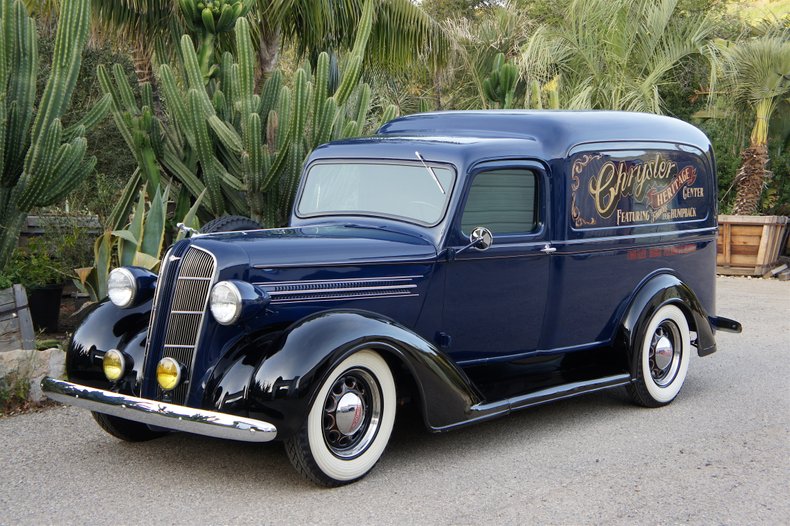Drivetrain
Chassis
Body

Dodge had announced an all-new line of trucks and commercial cars for 1936. The handsome Dodge trucks featured beautiful new styling that emphasized rounded contours and curved lines. Skirted fenders reflected the growing interest in streamline design during this era. One welcome change in body construction was the adaptation of front-hinged doors to replace the old “suicide-style” doors.
For smaller trucks in the D2 commercial line, Dodge switched to a single wheelbase for both car-based and truck-based models. Previously, two separate wheelbases had been offered. The D2 commercial sedan used a 217.8-cid L-head six with a 6.5:1 compression ratio that was rated for 87 hp at 3,600 rpm. Other Dodge trucks carried a slightly smaller 201.3-cid L-head six with a 5.8:1 compression ratio that produced 70 hp at 3,000 rpm.
New advances in Dodge truck technology included the use of new “Amola” springs (a recent Chrysler innovation) and a new “Fore-Point” load distribution system. With the Fore-Point layout, the engine and cab were shifted slightly forward to place more of the truck's payload on the front axle and wheels. This also permitted the use of longer body sheet metal.
Dodge's LE15 trucks were marketed with a three-quarter ton rating, but could also be outfitted as ton-and-a-half units for slight extra cost. The LE15s (as well as the one-ton LE20s, were now being built on the double-drop-type “truck” chassis for the first time. This meant the '36 models not only looked better, but most were quite a bit sturdier, too.
Standard equipment on trucks in the middle '30s was rather minimal. On LC models (like the one here on offer), it consisted of an ammeter, a speedometer, a fuel gauge, an oil pressure gauge, a heat indicator, a glove compartment, a hand choke, a throttle and vacuum windshield wipers. The 17-inch steering wheel was “adjustable” for height. The commercial sedan, and panel, as well as screen and canopy-side deliveries came standard with only one bucket seat. That increased load-carrying capacity.
Dodge introduced these trucks in November of 1935 and produced 109,392 trucks of all types (including larger ones) for calendar-year 1936. Of that total, just 8,599 units were manufactured in the company's Los Angeles plant and an additional 2,764 were built in Canada.
Truck sales for Dodge were growing so rapidly in this era that the company made two back-to-back expansions of its main Dodge plant in Hamtramck, Michigan (where this example was built) in as many years.
Dodge was, in fact, the country's third leading producer of trucks of all types and could build up to 800 per day.
*This article was written by John Gunnell and originally appeared in the April 17, 2008 issue of oldcarsweekly.com.
1936 Dodge LC 'Humpback' Panel Delivery
Dodge had announced an all-new line of trucks and commercial cars for 1936. The handsome Dodge trucks featured beautiful new styling that emphasized rounded contours and curved lines. Skirted fenders reflected the growing interest in streamline design during this era. One welcome change in body construction was the adaptation of front-hinged doors to replace the old “suicide-style” doors.
For smaller trucks in the D2 commercial line, Dodge switched to a single wheelbase for both car-based and truck-based models. Previously, two separate wheelbases had been offered. The D2 commercial sedan used a 217.8-cid L-head six with a 6.5:1 compression ratio that was rated for 87 hp at 3,600 rpm. Other Dodge trucks carried a slightly smaller 201.3-cid L-head six with a 5.8:1 compression ratio that produced 70 hp at 3,000 rpm.
New advances in Dodge truck technology included the use of new “Amola” springs (a recent Chrysler innovation) and a new “Fore-Point” load distribution system. With the Fore-Point layout, the engine and cab were shifted slightly forward to place more of the truck's payload on the front axle and wheels. This also permitted the use of longer body sheet metal.
Dodge's LE15 trucks were marketed with a three-quarter ton rating, but could also be outfitted as ton-and-a-half units for slight extra cost. The LE15s (as well as the one-ton LE20s, were now being built on the double-drop-type “truck” chassis for the first time. This meant the '36 models not only looked better, but most were quite a bit sturdier, too.
Standard equipment on trucks in the middle '30s was rather minimal. On LC models (like the one here on offer), it consisted of an ammeter, a speedometer, a fuel gauge, an oil pressure gauge, a heat indicator, a glove compartment, a hand choke, a throttle and vacuum windshield wipers. The 17-inch steering wheel was “adjustable” for height. The commercial sedan, and panel, as well as screen and canopy-side deliveries came standard with only one bucket seat. That increased load-carrying capacity.
Dodge introduced these trucks in November of 1935 and produced 109,392 trucks of all types (including larger ones) for calendar-year 1936. Of that total, just 8,599 units were manufactured in the company's Los Angeles plant and an additional 2,764 were built in Canada.
Truck sales for Dodge were growing so rapidly in this era that the company made two back-to-back expansions of its main Dodge plant in Hamtramck, Michigan (where this example was built) in as many years.
Dodge was, in fact, the country's third leading producer of trucks of all types and could build up to 800 per day.
*This article was written by John Gunnell and originally appeared in the April 17, 2008 issue of oldcarsweekly.com.




































